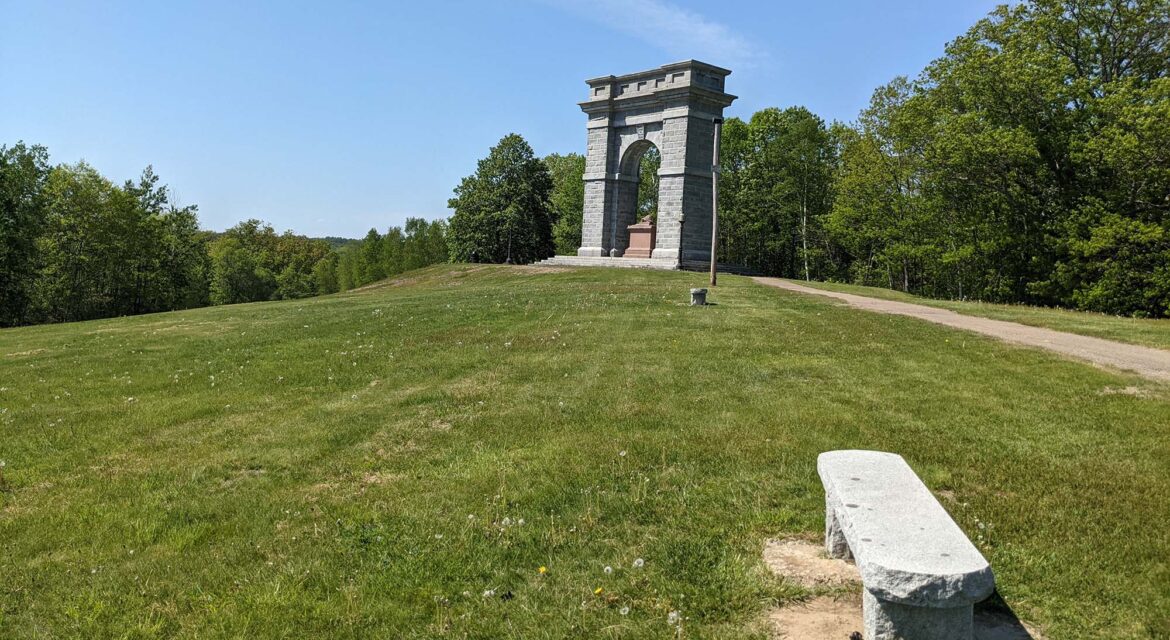 Overlooking the town of Tilton, New Hampshire, the Memorial Arch of Tilton was one of numerous monuments built by Charles E. Tilton. Inspired by a legendary monument, the arch was designed to serve as a final resting place for Tilton but also attract the attention of everyone in the vicinity. The endeavor has allowed the Arch to define a legacy that has come to shape and influence the entire region.
Overlooking the town of Tilton, New Hampshire, the Memorial Arch of Tilton was one of numerous monuments built by Charles E. Tilton. Inspired by a legendary monument, the arch was designed to serve as a final resting place for Tilton but also attract the attention of everyone in the vicinity. The endeavor has allowed the Arch to define a legacy that has come to shape and influence the entire region.

Inspired by the Arch of Titus
 Charles E. Tilton came up with the idea to build what would become the Memorial Arch of Tilton when he visited Rome in 1881. Inspired by the Arch of Titus, he sought to create a similar structure in the town that was named after his grandfather which would be connected to the triumph of peace rather than war. Construction was completed on the Memorial Arch in 1882.
Charles E. Tilton came up with the idea to build what would become the Memorial Arch of Tilton when he visited Rome in 1881. Inspired by the Arch of Titus, he sought to create a similar structure in the town that was named after his grandfather which would be connected to the triumph of peace rather than war. Construction was completed on the Memorial Arch in 1882.
Standing over 55 feet tall and measuring over 40 feet wide, the Memorial Arch of Tilton actually resides in the town of Northfield, as the hill it was built atop didn’t have any trees in the late 19th century, allowing the Arch to be seen from all across the area. This vantage point along with Tilton’s assumption of Northfield being incorporated into the city of Tilton determined the placement of the landmark, although the incorporation of Northfield never actually happened.
The keystone of the Arch contains a time capsule with newspapers, a book, and silver and gold coins. A pink-granite sarcophagus with a lion on top of it resides between the two columns at its base. While Tilton intended to be interred in this sarcophagus, he was actually buried a mile west, in Park Cemetery in Tilton.
The history, look and natural environment that defines how people can interact with the Memorial Arch of Tilton have allowed it to become an attraction for the region. These experiences have distinctly resonated for both residents and visitors in a way that has impacted the culture and economy of the area.

An Icon for Tilton
 Numerous maps and guides of Tilton and Northfield along with the wider region highlight the Memorial Arch of Tilton as a top attraction in the area. Various organizations and the city of Tilton itself have utilized the Arch as an icon that defines their identity, highlighting the profound impact it has created on the culture of the community.
Numerous maps and guides of Tilton and Northfield along with the wider region highlight the Memorial Arch of Tilton as a top attraction in the area. Various organizations and the city of Tilton itself have utilized the Arch as an icon that defines their identity, highlighting the profound impact it has created on the culture of the community.
The hilltop where the Arch resides is used for recreation and picnics but also for various community functions. It is an ideal spot to view the famous Old Home Day fireworks. The sheer beauty of the hillside provides visitors with look at the natural and constructed wonders that New Hampshire has to offer. It’s a combination evident in other nearby monuments.
Added to the National Register of Historic Places in 1980, the Memorial Arch of Tilton has been called a folly by some but seen as a point of pride by others. It highlights how monuments can not only define a legacy for individuals and entire cities, but also how those legacies can be shaped and interpreted in so many different ways.

The Unpredictable and Eternal Nature of Legacies
 Charles E. Tilton was focused on making his hometown the most beautiful place in the country, although he did so while also making sure to honor his own life and family name. Doing so has created a complicated legacy for the Memorial Arch of Tilton, which is further complicated by the landmark not even being located in the city of Tilton. All of these developments showcase how monuments can be used to shape and define legacies in ways that are as unpredictable as they are eternal.
Charles E. Tilton was focused on making his hometown the most beautiful place in the country, although he did so while also making sure to honor his own life and family name. Doing so has created a complicated legacy for the Memorial Arch of Tilton, which is further complicated by the landmark not even being located in the city of Tilton. All of these developments showcase how monuments can be used to shape and define legacies in ways that are as unpredictable as they are eternal.

